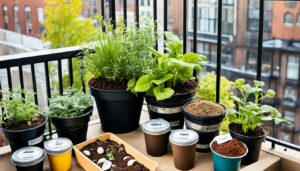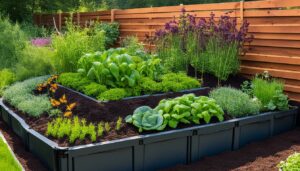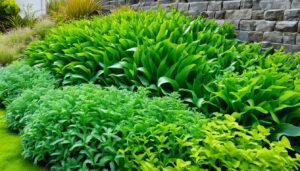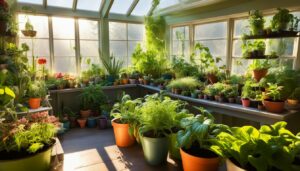There’s a certain magic found in the garden, a serene symphony where each plant holds a note—the low hum of roots mingling, the whisper of leaves brushing against one another. It’s here, in the soft cradle of the earth, where companion planting techniques transform a simple plot into a blooming orchestra. Whether you’re a seasoned horticulturist or a curious novice with a sliver of backyard, understanding the intricate dance of vegetable garden companion planting can turn your green space into a haven of interdependent life, where each plant’s strengths are shared, and vulnerabilities protected. This guide is a conjurer’s code—revealing 67 harmonious pairings of vegetables, herbs, and flowers, unsheathing the secrets of a time-honored practice that breathes vitality into the garden.
Imagine walking down the garden path, feeling the pride swell in your chest as you witness the fruits of herb companion planting, where the aromatic whispers of basil elevate the richness of your tomatoes. Picture yourself studying the vibrant hues of a companion planting chart, a treasure map that leads to a mixture of textures, colors, and fragrances, weaving a tapestry of life that’s as beautiful as it is beneficial. The wisdom of companion planting is not solely about yielding a more bountiful harvest, but nurturing a space where life supports life—where everything grows better together.
Key Takeaways
- Mastering companion planting can create a symphonic ecosystem in your own backyard.
- Discover 67 vegetable, herb, and flower pairings that promote a healthy and productive garden.
- Unlock the natural chemistry between plants for pest control and enhanced growth.
- Learn the ancient art and science behind strategic plant relationships.
- Access easy-to-follow companion planting charts to simplify garden planning.
- Embrace the permaculture principles that bring resilience and abundance to your garden.
Exploring the Foundations of Companion Planting
Delving into the world of gardening, the practice of companion planting emerges as a timeless tradition, juxtaposed against the backdrop of modern agricultural monoculture. This ancient technique, deeply rooted in the wisdom of bygone eras, thrives on the diversity and symbiosis of plant relationships. Today’s companion planting guide is a treasure trove of insights, directing gardeners towards harnessing these relationships for a more fruitful harvest.
At the core of companion planting lies the principle of interdependence among different plant species. It is an intricate dance of give-and-take where, for instance, the best companion plants pair nitrogen-fixing legumes with nitrogen-enthusiastic crops like corn. This partnership not only fortifies the soil with essential nutrients but also casts the corn stalks in the supportive role of a trellis for climbing beans.
Mimicking natural ecosystems, companion planting serves as an organic strategy that diminishes the dependency on chemical fertilizers. It prizes the understanding of each plant’s unique physiological and biological attributes, applying this knowledge to encourage a healthier, more balanced garden milieu. Let’s consider some companion planting tips:
- Select pairs that complement each other, such as tall plants offering shade to heat-sensitive shorter companions.
- Utilize fragrant herbs to deter pests, reducing the need for artificial interventions.
- Integrate flowering plants to attract a host of pollinators, thus ensuring a well-pollinated garden.
It’s a transformative approach that beckons with its simple elegance: plants coexisting and thriving not in isolation, but woven together in a living, breathing tapestry that benefits the whole garden. By embracing the essence of companion planting, gardeners can unlock the secret bond between plants – a synergy as old as agriculture itself.
Uncovering the Benefits of Companion Planting
When delving into the intricacies of a thriving garden, the benefits of companion planting become undeniably clear. It’s not merely about the aesthetic ensemble of colors and textures, but also about the essential relationships and synergies that form between plant species. The resulting biodiversity is the cornerstone of a resilient and flourishing garden ecosystem.
The Synergy Among Plants
One of the most classic examples of plant synergy consists of the ‘three sisters’—a triad of corn, beans, and squash—which embodies the essence of companion planting benefits. Through their collective existence, they demonstrate how varied species can coexist to provide structural support, pest deterrence, and optimal soil conditions. It’s this kind of natural harmony that contributes to increased pollination, improved soil health, and an elevation in overall biodiversity within the garden landscape.
Building a Natural Defense System
Nature has its own elegant way of dealing with potential threats, and with companion planting for disease prevention, gardeners can tap into these methods for natural pest control. Take, for instance, the pungent whiff of onions, which efficiently steers carrot flies away, or consider the role of marigolds, which boast a reputation for repelling nematodes with their bright blossoms. These examples illustrate how integrating certain plants into your companion plant list can lead to a significant reduction in the use of chemical pesticides, fostering not just plant health but also ecological well-being.
Nitrogen Fixers: Nature’s Fertilizers
Nitrogen-fixing plants, particularly legumes, are invaluable allies in the garden. Their ability to fix atmospheric nitrogen and convert it into a usable form enriches the soil, playing a pivotal role in supporting neighboring plant life. This natural fertilization process is a boon for heavy feeders such as corn, promoting their growth and vitality. As a key strategy in crop rotation, incorporating nitrogen-fixing plants into one’s companion plant list is essential for maintaining long-term soil fertility and plant health.
| Nitrogen-Fixing Plant | Benefits to Companion Plants | Companion Plant Examples |
|---|---|---|
| Clover | Fixes nitrogen; attracts beneficial insects | Brassicas, lettuce, strawberries |
| Beans | Adds nitrogen to soil; provides structural support | Corn, squash, cucumbers |
| Peas | Enriches soil with nitrogen; promotes soil health | Carrots, turnips, radishes |
Implementing companion planting strategies is more than just a gardening trend; it’s a commitment to fostering a rich, self-sustaining environment where plants not only look good together but also support each other’s growth in fundamental ways. With the incorporation of diversity in the garden, we pave the way for a healthier, more vibrant, and productive ecosystem that thrives year after year.
Enriching Your Soil with Companion Planting Techniques
Companion planting strategies offer gardeners an eco-friendly path to soil enrichment. Beyond merely positioning plants side by side for pest control or aesthetic purposes, deliberate selection and placement can transform the very foundation your garden thrives upon – the soil. This approach to gardening taps into the natural symbiosis of plant interactions to enhance nutrient exchange and moisture regulation within the Earth’s crust, creating a self-sustaining micro-ecosystem beneath our feet.
One of the primary benefits of utilizing companion planting strategies lies in promoting nutrient uptake. The process is facilitated by plants with varying root depths. Deep-rooted species act as natural tillers, reaching down into the mineral store of the subsoil and bringing those nutrients up to the topsoil. These nutrients become accessible to plants with shallower root systems, creating a loop of nutritional benefits that maintains soil fertility without the need for artificial fertilizers.
| Companion Plant | Beneficial Role | Companions |
|---|---|---|
| Legumes (Peas, Beans) | Nitrogen-fixing | Corn, Squash |
| Deep-rooted Vegetables (Carrots, Radishes) | Nutrient mining and aeration | Lettuce, Spinach |
| Cover Crops (Clover, Alfalfa) | Soil protection and moisture retention | Main-season crops post-harvest |
Moreover, certain plants provide a living mulch—a cover that helps to maintain optimal soil temperature and reduces evaporation. This natural blanket conserves water and shields the soil from the compacting force of raindrops. Utilizing plants like Squash as ground cover reduces the need for additional mulching materials, trimming down garden maintenance costs and efforts.
Companion planting, therefore, isn’t just about the flora above the ground; it is about curating a below-ground sanctuary that enhances soil biology and chemistry. By fostering these alliances, gardeners gift their soil—and their crops—a legacy of health and abundance. So embrace these natural partnerships and witness your garden flourish as nature intended.
The Perfect Pairings: A Companion Plant List
Embarking on the journey of vegetable garden companion planting unveils a world of symbiotic relationships and effective plant pairings that can significantly boost garden health and productivity. Understanding this intricate dance of flora can lead to bountiful harvests and a vibrant garden ecosystem. Let’s explore some of the star performers in this natural ballet of companion planting.
Vegetable Garden Companions
Key partnerships in the vegetable garden provide more than just visual diversity—they create a thriving system where each plant contributes to the success of another. For instance, the classic duo of tomatoes and basil stands out not only for their culinary compatibility but also for their mutual support in the garden, with basil acting as an aromatic pest deterrent warding off insects with its strong scent.
Herbs That Help Vegetables Thrive
Herbs are the unsung heroes of herb companion planting, offering their protective aromas to shield vegetables from a variety of pests. Interspersing herbs like rosemary, sage, and dill among vegetables can create a defensive shield, leveraging their volatiles to maintain the delicate balance of the ecosystem.
Flower Power: How Blooms Boost Your Garden
The use of flowers extends beyond aesthetic allure in the practice of using flowers in vegetable gardens. They are pivotal in attracting beneficial pollinators and repelling pests. A companion planting chart often highlights the prowess of marigolds and nasturtiums as prime examples of this advantageous integration.
When planning your garden, a reference to a detailed companion planting chart is invaluable. Below is a curated table showcasing some of the top companion planting pairings for a flourishing garden:
| Vegetable | Companion Plant | Benefit |
|---|---|---|
| Tomatoes | Basil | Repels pests, may enhance flavor |
| Lettuce | Spinach | Provides shade, prevents bolting |
| Carrots | Chives | Deters carrot fly |
| Beans | Marigolds | Suppresses nematodes |
| Cucumbers | Nasturtiums | Acts as trap crop for aphids |
| Peppers | Parsley | Attracts beneficial insects |
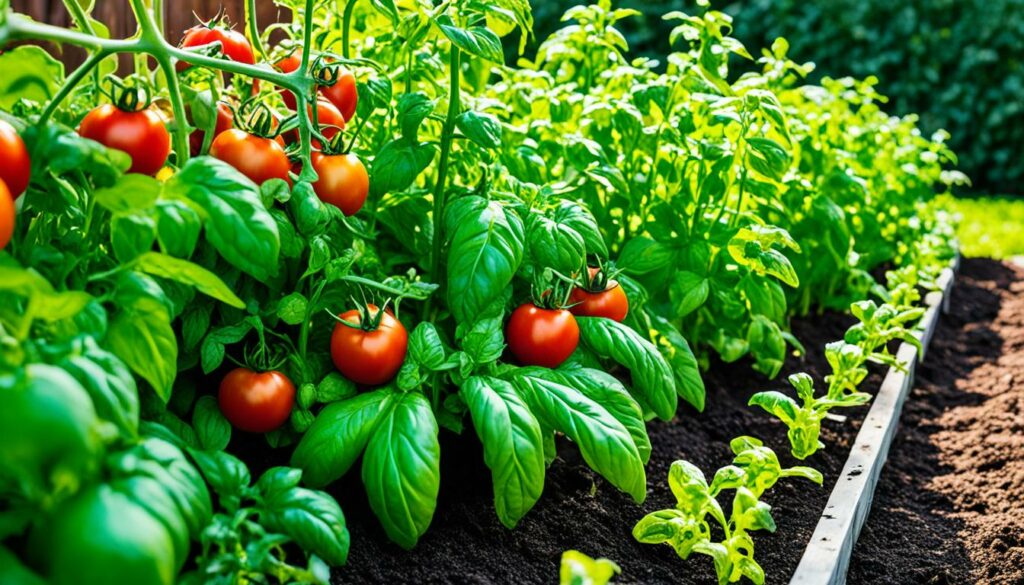
Planning Your Garden with an Intercropping Guide
Intercropping, a cornerstone of sustainable garden design, not only maximizes the use of space but also capitalizes on the synergistic interactions between various plants. By meticulously planning the arrangement of your crops, you can significantly boost your garden’s productivity. Let’s delve into the intricacies of crafting an intercropping layout and the importance of precise planting timing and crop sequencing.
Designing Your Intercropping Layout
When mapping out your garden, consideration for the specific needs of each plant leads to a seamless intercropping guide that ensures balanced resource distribution. Sunlight, water access, and nutrient requirements need to be accounted for to avoid competition and promote mutual benefits among the flora.
Timing and Sequencing Your Planting
The success of an intercropped garden hinges on meticulous planting timing and strategic crop sequencing. To ensure a continuous and efficient harvest, one must pair fast-growing crops with those of slower maturity. This not only maximizes space usage but also maintains soil fertility and helps in the control of pests and diseases.
| Crop | Planting Timing | Companion Crop | Benefits |
|---|---|---|---|
| Radishes | Early Spring | Carrots | Radishes mature quickly, marking space for slower-growing carrots. |
| Beans | Late Spring | Corn | Beans fix nitrogen that benefits corn, while cornstalks act as natural trellises. |
| Spinach | Autumn | Strawberries | Spinach provides ground cover, reducing weed competition for strawberries. |
| Garlic | Autumn | Roses | Garlic deters pests that commonly affect roses. |
By integrating these principles of intercropping, gardeners can create a tapestry of productivity, where each plant contributes to the success of its neighbors. This not only contributes to a lush and abundant garden but also to one that is more resilient and harmonious with the natural ecosystem.
A Deep Dive into Herb Companion Planting
Embarking on the journey of herb companion planting is a rewarding endeavor that promises to enhance the vitality and productivity of any garden. With a strategic approach to combining herbs, gardeners can unlock the full potential of their herb garden, creating a tableau of both beauty and functionality. However, understanding the synergy among various herbs and their impact on neighboring plants is crucial for maximizing herb garden potential.
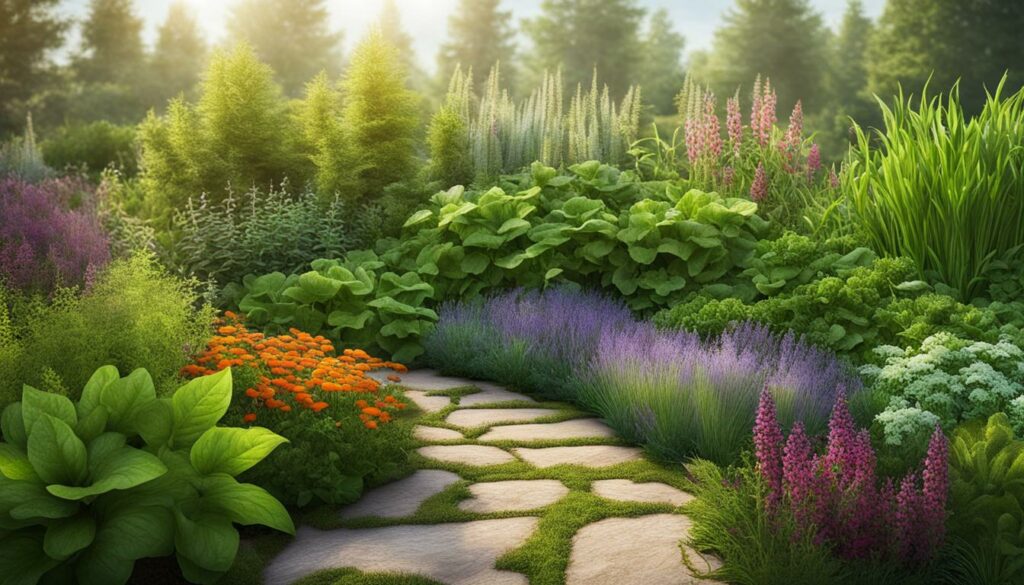
Not all herbs harmonize in the garden; some, like fennel, are known to be somewhat aloof, negatively affecting the growth of many other plants. On the other hand, basil is celebrated for its friendship with tomatoes, enhancing their growth and flavor. The key to effective companion planting is navigating these relationships efficiently to cultivate a lush and abundant herb garden. The table below categorizes select herbs based on their companionability, helping you plan a cohesive and thriving herb garden.
| Beneficial Herb Companions | Herbs to Plant Separately |
|---|---|
| Basil with Tomatoes | Fennel (generally solitary) |
| Chives with Carrots | Dill away from Carrots |
| Mint with Cabbage | Wormwood away from most herbs |
| Parsley with Asparagus | Rue away from Basil and Sage |
| Coriander with Spinach | Anise away from most herbs |
Reflecting on the listed combinations, gardeners should note the importance of not simply juxtaposing herbs, but rather carefully considering their unique interactions. These pairings are just the beginning—there is a multitude of possible combinations that harness the power of companion planting to create a robust herb garden. Remember, the key to success lies in recognizing the individual needs and growth patterns of each herb, ensuring they provide mutual benefits when planted together. By doing so, you will naturally bolster your garden’s defenses against pests, improve pollination, and enhance the overall garden ecosystem.
Maximizing Yields with the Best Companion Plants
Understanding the symbiotic relationships in a garden is crucial to increasing garden yields. The selection and pairing of the best companion plants can lead to an explosion of productivity. Plants, when carefully chosen, support one another in ways that not only increase output but also improve flavor and health of the produce. Below is a guide to constructing an efficient companion plant matrix:
One of the simplest yet most effective strategies is to pair nitrogen-fixers like beans and peas with heavy-feeding plants such as corn and squash. This allows the soil to be enriched naturally, catering to the nutritional needs without resorting to chemical fertilizers. Flowering plants, too, play a vital role by attracting a myriad of pollinators. For example, the vibrant blooms of sunflowers draw bees which in turn enhance the fruiting of neighboring crops. Aromatic herbs, like lavender and mint, repel unwanted pests, reducing the likelihood of infestations and diseases.
| Nitrogen-Fixer | Companion Plant | Benefits |
|---|---|---|
| Clover | Brassicas (Cabbage, Broccoli) | Improves soil structure & provides nitrogen |
| Peas | Carrots | Enhances growth & flavor |
| Beans | Corn | Beans fix nitrogen & corn provides support |
Integrating best companion plants is not just about enhancing fertility and managing pests. It’s about creating a garden that is inherently supportive, with plants that cover the soil, provide necessary shade, and contribute to a balanced ecosystem that mimics nature’s own balanced design. As you plan your garden, think of it as building a community—where each plant offers something unique and essential—to ensure a bountiful harvest that is truly sustainable.
Conclusion
Embracing companion planting is more than a gardening trend; it’s a return to an eco-conscious way of life that prioritizes garden health and a harmonious relationship with nature. This ancient practice, refined through modern understanding, serves as the backbone of a diverse and thriving garden. A well-executed companion planting strategy can lead to abundant harvests, robust in both quantity and quality. Gardeners who invest time in learning and applying these techniques often find that their efforts are rewarded manifold.
Moreover, the pursuit of companion planting success transcends the mere act of positioning plants side by side. It fosters an ecosystem where every living component—from the tiniest soil microbe to the tallest sunflower—plays a role in a grand symphony of growth. Such systems require less intervention, reducing the need for synthetic aids and allowing nature to take its course, leading to natural pest management and soil preservation. This cost-effective and satisfying gardening approach marks a significant step towards sustainability.
Ultimately, whether your garden is a sprawling landscape or a modest backyard plot, the principles of companion planting can elevate it to new heights. By harnessing the symbiotic relationships between plants, gardeners can enhance the vitality of their green spaces. The message is clear: adopt companion planting, delve into this green wisdom, and watch as your garden transforms into an oasis of biodiversity that contributes to a healthier, greener world.



